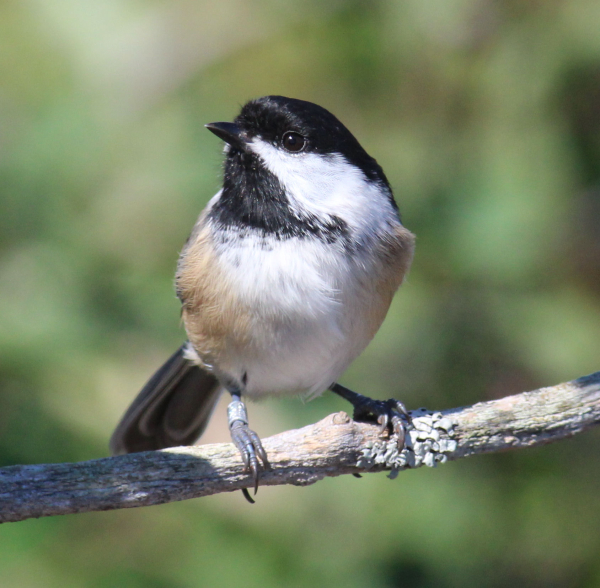
Will you think differently about the Black-capped Chickadees that visit your feeders and backyard habitat after reading this article?
|
Many birds migrate to warmer locations with more food options, they must endure long, often perilous migrations and increased competition. Some familiar feeder visitors like Black-capped Chickadees remain in northern latitudes year-round. Birds that stay north when the snow flies face 2 daily dilemmas – don’t freeze, and don’t starve. Most birds follow a simple winter survival formula: Maximize the calories of foods eaten while minimizing calories spent finding food, sheltering, and keeping from freezing in cold and even ultra-cold weather.
Small birds maintain an elevated body temperature to stay active – generally about 105°F – compared to birders who live in the north, with our 98.6°F body temperatures. Finding enough food is likewise paramount when most food supplies become greatly reduced during winter weather, just when food is required most to fuel their body and keep it warm.
Cold Feet
Black-capped Chickadees, like most birds that spend the calendar year in northern latitudes, contend with the winter with bare uninsulated legs and feet. Yet their toes remain flexible and functional at all temperatures; whereas our feet, if that small, would freeze into blocks of ice in seconds.
How do they do this? First, a bird’s comfort level for foot temperature is likely very different from ours; they shouldn’t feel uncomfortable until the point when physical damage occurs from freezing (ice crystal formation). Small birds’ feet cool down to near freezing, close to 30°F during cold winter temperatures. But chickadees’ feet don’t freeze, and that’s because their foot temperature is regulated near the freezing point and may stay cold most of the time all winter long, even as their core body temperature stays high.
Every time a chickadee sends heat via blood from the body core to the extremities, it must produce more heat in the core. Therefore, if a chickadee maintained its feet at the same temperature as its body core, it would lose heat very rapidly, and that would be so energetically costly that any bird would quickly be calorie depleted. Birds that maintained warm feet would unlikely be able to feed fast enough to stay warm and active.
However, a chickadee’s feet receive continuous from the warm arterial blood flowing from the body to the feet – next to veins of cooled blood returning from the feet to the body. As heat is transferred between the outgoing and incoming venation, the blood returning to the body has recovered much of the heat that would otherwise be lost when flowing through the feet.
Retaining Body Heat
Birds retain heat in their body core by fluffing out their feathers. Chickadees may appear to be twice as fat during winter as summer, but they aren’t. They merely puffed up their feathers, creating a thicker insulation around their bodies that contains a layer of body-heated air.
At night, they reduce heat loss by seeking shelter in tree cavities or other holes or crevices, and by reducing their body temperature. That makes the difference in temperature between the bird and its environment is the smaller, which reduces the rate of heat loss. Still, the bird may burn up most off its fat reserves overnight, which then must be replenished the next day in order to survive the following night.
Nighttime is crunch time for chickadees’ winter survival because no food calories are being consumed to replace those being expended to stay warm. It’s a tight energy balance, but by reducing their body temperature, chickadees and other small birds of winter spare the cushion of fat they should have accumulated during the day.
Winter Food Searches
While physiology is a key component of surviving the cold by temperature regulation, the more critical factor is getting enough to eat. A little chickadee’s internal physiology must be fed regularly. Following chickadees in the winter woods and watching them closely reveals another secret of their winter survival. Chickadees often travel in loose flocks during winter and, in Maine, the author seldom sees them alone. Exploring for food, they appear to pick at just about everything, and when one chickadee finds something to eat, others notice and join in. All the while a winter chickadee flock learns by trial and error, and from one another.
For foraging chickadees, winter food options are still varied, ranging from different kinds of seeds, to spider eggs, insect pupae, and small spiders and insects when available. Invertebrates are seldom be seen in the open during winter in the frozen North, but they’re around – hidden in the ground, under bark, among plants – as they employ their own winter survival strategies.
Some caterpillars overwinter in a frozen solid state, attached to tree branches. In one instance the author found a flock of chickadees feeding on minute caterpillars hidden within the scale-like evergreen leaves of a cedar tree. Some lucky chickadee discovered this cache of frozen caterpillars, perhaps with the help of a clue – possibly a blemished stain on the leaf from the caterpillars’ prior feeding.
Of course, the luckiest chickadees may be those that find a backyard feeding station that’s kept stocked with high-calorie foods like seeds and nuts and suet. Keep this information in mind when you’re providing food for wild birds and enjoying them out your windows or from your deck. And we bet that you will have a little different impression of those little chickadees and other birds feeding on your generous winter banquet. Enjoy the birds you attract and benefit throughout the winter, and appreciate their daily search for food, cover, and water.
Most of the above information was originally published as a portion of an article authored by Bernd Heinrich, Professor Emeritus of Biology at the University of Vermont. For more information about winter bird survival strategies, you can refer to the original Living Bird article at https://www.allaboutbirds.org/news/how-do-birds-survive-the-winter/